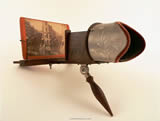 |
|
America & The World
The 20th century dawned on an America bursting with optimism and energy. The United States had just arrived on the world stage by vanquishing the Spanish empire and grabbing one of its own. In the years between the Spanish-American War and the outbreak of the Great War in Europe in 1914, the United States reshaped its perception of, and its place in the world, even as the world arrived on its doorstep via the largest wave of human immigration in world history. In 1900, the majority of Americans still a rural lifestyle without electricity. New technologies such as recorded sound, film, and the automobile were still in their infancies; and the radio and mass media were still several decades away. And yet, as Americans assessed their new world status, they developed a curiosity about the world and explored it through the resources and technologies that were available. These included books (both fiction and non-fiction), periodicals, and stereoviews.
A more detailed examination of this topic is planned for the future. In the meantime, this small collection of images is presented. |
|
| |
Of the scholarly works on travel and foreign countries, none sold in the United States as prolifically as did John L. Stoddard's Lectures. John Stoddard began traveling the world around 1874, and first began writing about it in 1884. He then turned his experiences into a series of popular academic lectures delivered throughout the country. In 1897-1898, Stoddard transformed his lectures into a series of books named John Stoddard's Lectures. The essays extensively covered such topics as art, architecture, history, natural history, and archaeology, and were profusely illustrated with photographs from Stoddard's personal collection. The countries and regions discussed include Norway, Switzerland, Athens, Venice, Constantinople, Jerusalem, Egypt, Japan, China, India, France, Spain, Berlin, Vienna, Moscow, The Rhine, Belgium, Holland, Mexico, Florence, Naples, Rome, Scotland, England, Southern California, Ireland, Denmark, Sweden, Canada, Malta, Gibraltar, South Tyrol, The Dolomites, Sicily, Genoa, and Bohemia. Numerous editions of John Stoddard's Lectures were published, and many survive to this day.
Monthly and weekly periodicals also provided American readers with feature stories and articles about different cultures and places. Harper's Monthly, Schribner's Magazine, Life and others presented the world in both fiction and non-fiction, often accompanied by detailed engravings. |
|
| |
Children's Literature
For the younger reader, there was no shortage of imaginary tales set in far off places. Perhaps most famous of all the children's adventure literature was British author Rudyard Kipling's The Jungle Book, first published in 1894. These stories were so popular in the United States that the Cub Scouts received permission to use it as a motivational book. Inspired by Kipling, American authors came to realize that the dark and mysterious places of the world unknown to most American provided the perfect settings for adventure stories. This new genre of literature usually featured white protagonists, many of them children. The most popular settings were the dark continent of Africa, and the mysterious "Orient". In Africa the Whites always encountered strange beasts and men, cannibalism, witchcraft, and black characters lacking in depth or morality. Orientals too were cunning, deceitful, merciless opium-smoking fiends. These foreign adventure stories successfully depicted the non-white peoples of the world as "the other," a tradition that had begun generations earlier in American's of non-European descent, including Native Americans. The most enduring of these adventure stories is the character of Tarzan, first published by Edgar Rice Burroughs in 1914. |
|
|
| Other children's adventure fiction involved more militaristic plots and settings. These stories had become popular during the Spanish-American War and the genre continued producing titles even during the more peaceful years leading up to the Great War in 1914. |
|
| |
| The stereoptic viewer (or stereoviewer) was first made available to the American public in 1858. It's popularity began to diminish after the invention of the 35mm camera in 1900, but stereoptic viewers and the cards that went with them continued to be manufactured into the 1920s. The stereoview card has two nearly identical images side-by-side. When viewed through the stereoviewer, the images are combined into a single image, creating the illusion of depth. Subjects of interest to the public included urban street scenes and city life, as well as images of Native Americans (see the section on the surrender of Sitting Bull). By the turn of the century, images of life in other countries became extremely popular and played a large role in the formation of imagery and attitudes in the minds of Americans towards other countries, civilizations, and races. |

Stereoptic Viewer (2 views)
|

Coffee Pickers, French West Indies, c.1899 (2 views)
|

Unloading Bananas, Cuba, c.1899 (2 views)
|

Children Playing Hop Scotch, Cashmere, c.1900 (2 views)
|

Queen Street, Hong Kong, c.1900 (2 views)
|

Little Parisians in Monceau Park, Paris, c.1900 (2 views)
|

Mission Children, Canton, China, c.1900 |

Overlooking the Thames, London, England, c.1900 (2 views)
|

Peasant Children, Rome, Italy, c.1900 (2 views)
|

Plowing Scene Near Seoul, Korea, c.1900 (2 views)
|

Salt Fields, Russia, c.1900 (2 views)
|

Dutch Villagers on Fishermen's Wharf, c.1900 (2 views)
|
|
|
|
|
| |
|

|
|
|
|
|
|
|
|
|
|

